Getting started with Microchip: PIC32MZ-DA
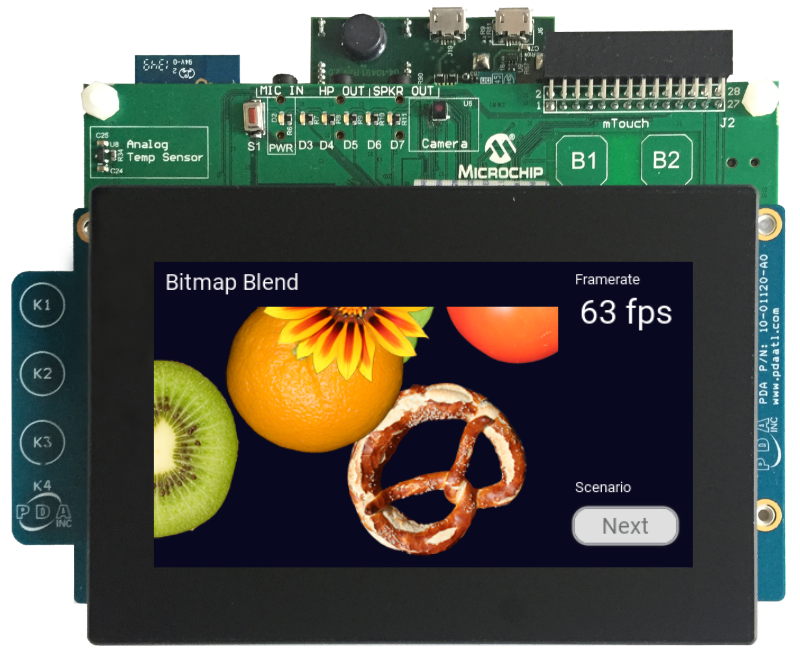
PIC32MZ-DA Evaluation Kit with Multimedia Expansion Board II.
The following article explains all necessary steps to create an Embedded Wizard UI application suitable for the PIC32MZ-DA Evaluation Kit (DM320008 or DM320010) in combination with the Multimedia Expansion Board II (DM320005-5). Please follow these instructions carefully and step by step in order to ensure that you will get everything up and running on your target. Moreover, this article assumes, that you are familiar with the basic concepts of Embedded Wizard.
Prerequisites
First of all, you need the following hardware components:
★PIC32MZ-DA Embedded Graphics Starter Kit with Stacked DRAM (DM320010) from Microchip or PIC32MZ-DA Embedded Graphics Starter Kit with External DRAM (DM320008) from Microchip
★Multimedia Expansion Board II (DM320005-5) from Microchip
★MPLAB ICD 3 In-Circuit Debugger (DV164035) or MPLAB ICD 4 In-Circuit Debugger (DV164045) from Microchip
Download the following software packages from Microchip website:
Additionally, make sure that you have got the following software packages:
★Embedded Wizard Studio Free or Embedded Wizard Studio Pro
★Embedded Wizard PIC32 Platform Package
★Embedded Wizard Build Environment for PIC32MZ-DA-MEB-II
TIP
If you want to use the Free edition of Embedded Wizard Studio and the PIC32 Platform Package, please register on our website and select the target PIC32MZ-DA-MEB-II. Then you can download the above software packages.
All customers who licensed Embedded Wizard can visit our download center to get the above software packages.
Installing Tools and Software
★Step 1: Install the latest version of Embedded Wizard Studio.
★Step 2: Install the Embedded Wizard PIC32 Platform Package.
★Step 3: Install the Microchip tools: MPLAB-X IDE, Harmony and XC32 Compiler.
★Step 4: Unpack the provided Embedded Wizard Build Environment for PIC32MZ-DA-MEB-II to your local file system (e.g. C:\Microchip[.]).
IMPORTANT
The Build Environment for PIC32MZ-DA-MEB-II supports only the supports only the PIC32MZ-DA hardware configurations as described above. Other hardware and display combinations of the evaluation board are not tested.
Exploring the Build Environment
The provided Embedded Wizard build environment for PIC32MZ-DA-MEB-II contains everything you need to create, compile, link and flash an Embedded Wizard UI application for the PIC32MZ-DA-MEB-II target. After unpacking, you will find the following subdirectories and files:
•StartGccBuildEnvironment_DAG169.bat / StartGccBuildEnvironment_DAA288.bat - These script files are provided to start a windows command line to build your GUI applications suitable for the desired target.
•\Application - This folder contains ready-to-use projects to compile and link an Embedded Wizard generated UI application. They are used for all provided examples and they can be used to build your own UI applications.
•\GeneratedCode - This folder is used to receive the generated code from an Embedded Wizard UI project. All template projects are building the UI application out of this folder. You can create your own UI project and generate the code into the subdirectory \GeneratedCode without the need to adapt the project.
•\Project - This folder contains the prepared projects for GCC (make) and MPLAB-X.
•\Source - This folder contains the files main.c and ewmain.c. There you will find the initialization of the system and the main loop to drive an Embedded Wizard GUI application. The file ewconfig.h contains general configuration settings for the target system, like memory ranges and display parameter and configuration settings for the Embedded Wizard Graphics Engine and Runtime Environment. Additionally, this folder contains the device driver C/H files used for the DeviceIntegration example.
•\Examples - This folder contains a set of demo applications. Each example is stored in a separate folder containing the entire Embedded Wizard UI project. Every project contains the necessary profile settings for the PIC32MZ-DA-MEB-II target. The following samples are provided:
•\HelloWorld - A very simple project that is useful as starting point and to verify that the entire toolchain, your installation and your board is properly working.
•\ColorFormats - This project demonstrates that every UI application can be generated for different color formats: RGBA8888, RGB565, Index8 and LumA44.
•\ScreenOrientation - This demo shows, that the orientation of the UI application is independent from the physical orientation of the display.
•\DeviceIntegration - This example shows the integration of devices into a UI application and addresses typical questions: How to start a certain action on the target? How to get data from a device?
•\GraphicsOperations - This application demonstrates the graphics performance of the target by using sets of basic drawing operations that are executed permanently and continuously.
•\BrickGame - The sample application BrickGame implements a classic "paddle and ball" game. In the game, a couple of brick rows are arranged in the upper part of the screen. A ball travels across the screen, bouncing off the top and side walls of the screen. When a brick is hit, the ball bounces away and the brick is destroyed. The player has a movable paddle to bounce the ball upward, keeping it in play.
•\ClimateCabinet - The ClimateCabinet demo shows the implementation of a control panel for a climatic exposure test cabinet. The user can define a heating time, a nominal temperature and humidity, a dwell time and the final cooling time.
•\Dashboard - The sample application Dashboard shows the implementation of a car dashboard. The application demonstrates the usage of vector graphics created from svg path data and how transitions between two dashboard variants and further UI components can be achieved.
•\PaperCutter - This demo shows the implementation of a paper cutting machine, where the user can define the pagination and format of the paper as well as the cutting speed and the amount of papers. The application contains many rect effects and fade-in/fade-out effects to change dynamically the layout of the screen.
•\PulseOximeter - The sample application PulseOximeter shows the implementation of a medical device for monitoring a person's pulse frequency and peripheral oxygen saturation. The application demonstrates the usage of vector graphics within graphs and circular gauges.
•\SmartThermostat - The SmartThermostat demo application shows the implementation of a fancy, rotatable temperature controller to adjust and display the nominal and actual temperature.
•\WashingMachine - This demo shows the implementation of a washing machine with a couple of fancy scrollable list widgets to choose the washing program and parameters. The speciality of this sample application is the magnification effect of the centered list items and the soft fade-in/fade-out effects.
•\WaveformGenerator - This WaveformGenerator demo application combines waveforms with different amplitudes and frequencies. The implementation shows the usage of vector graphics to draw a curve based on a list of coordinates.
•\PlatformPackage - This folder contains the necessary source codes and/or libraries of the PIC32 Platform Package: Several Graphics Engines for the different color formats (RGBA8888, RGB565, Index8 and LumA44) and the Runtime Environment (in the subdirectory \RTE).
•\TargetSpecific - This folder contains all configuration files and platform specific source codes. The different ew_bsp_xxx files implement the bridge between the Embedded Wizard UI application and the underlying board support package (Microchip hardware drivers) in order to access the display, the serial interface and the clock.
•\ThirdParty - This folder contains third-party source codes and tools:
•\Make - This folder contains a make tool to build the entire GUI application via command line.
Creating the UI Examples
For the first bring up of your system, we recommend to use the example 'HelloWorld':
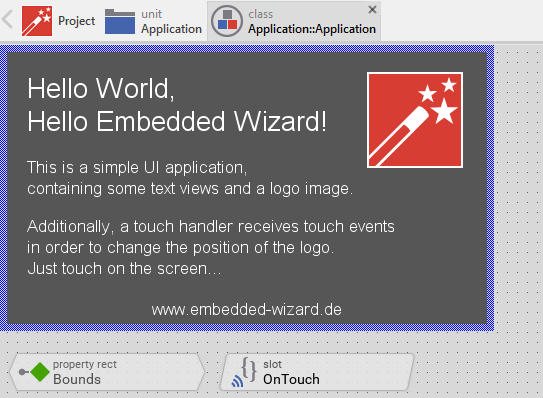
Example 'HelloWorld' within Embedded Wizard Studio.
The following steps are necessary to generate the source code of this sample application:
★Navigate to the directory \Example\HelloWorld.
★Open the project file HelloWorld.ewp with your previously installed Embedded Wizard Studio. The entire project is well documented inline. You can run the UI application within the Prototyper by pressing Ctrl+F5.
★To start the code generator, select the menu items - or simply press F8. Embedded Wizard Studio generates now the sources files of the example project into the directory \Application\GeneratedCode.
Compiling, Linking and Flashing
The following steps are necessary to build and flash the Embedded Wizard UI sample application using the GCC ARM embedded toolchain:
★Navigate to the top level of the Build Environment.
★If your are using the PIC32MZ-DA Embedded Graphics Starter Kit with Stacked DRAM (DM320010), then start the file StartGccBuildEnvironment_DAA288.bat. If you are using the PIC32MZ-DA Embedded Graphics Starter Kit with External DRAM (DM320008), then start the file StartGccBuildEnvironment_DAG169.bat. In both cases, a windows command line window should open. In case there are error messages, please edit the file and double-check the path settings.
★Now start compiling, linking and flashing:
make make install
If everything works as expected, the application is now executed on your PIC32MZ-DA-MEB-II target.
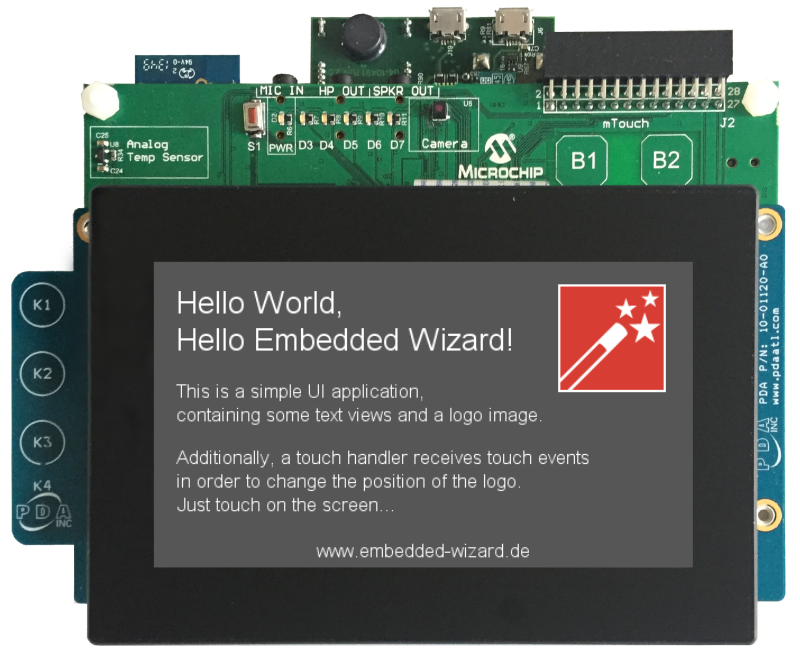
Example 'HelloWorld' running on PIC32MZ-DA-MEB-II development board.
All other examples can be created in the same way: Just open the desired example with Embedded Wizard Studio, generate code and rebuild the whole application using simply:
make install
Creating your own UI Applications
In order to create your own UI project suitable for the PIC32MZ-DA-MEB-II target, you can create a new project and select the PIC32MZ-DA-MEB-II project template:

As a result you get a new Embedded Wizard project, that contains the necessary Profile attributes suitable for the PIC32MZ-DA-MEB-II development board:
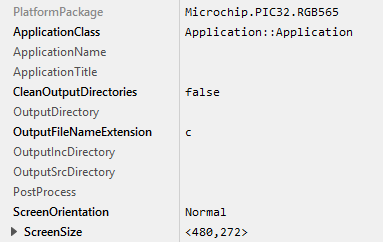
The following profile settings are important for your target:
★The attribute PlatformPackage should refer to an installed PIC32 Platform Package.
★The attribute ScreenSize should correspond to the display size of the PIC32MZ-DA-MEB-II development board.
★The attributes ModeOfBitmapResources and ModeOfStringConstants can be set to DirectAccess in case that the resources should be taken directly from flash memory. By default these attributes are set to Compressed.
★The attribute OutputDirectory should refer to the \Application\GeneratedCode directory within your Build Environment. By using this template, it will be very easy to build the UI project for your target.
★The attribute CleanOutputDirectories should be set to true to ensure that unused source code within the output directory \Application\GeneratedCode will be deleted.
★The attribute PostProcess should refer to \Application\Project\MPLAB\EmbeddedWizard_PostProcess\MPLAB_ew_post_process.cmd if you are working with MPLAB-X. In case of the GCC ARM embedded toolchain leave it blank
Now you can use the template project in the same manner as it was used for the provided examples to compile, link and flash the binary.
After generating code, please follow these steps, in order to build your own UI application:
★Depending on your hardware, start the batch file StartGccBuildEnvironment_DAG169.bat or StartGccBuildEnvironment_DAA288.bat. Again, a windows command line window should open.
★Start compiling, linking and flashing:
make install
Most of the project settings are taken directly out of the generated code, like the color format or the screen orientation. Only a few additional settings can be configured directly within the Makefile.
Console output
In order to receive error messages or to display simple debug or trace messages from your Embedded Wizard UI application, a serial terminal like 'Putty' or 'TeraTerm' should be used.
★As soon as you connect your PIC32MZ-DA-MEB-II target with the PC via USB, a new virtual Com Port appears within your system device list. Open the device manager to get the port number of this COM port. The USB port on the PIC32MZ-DA-MEB-II board is signed as UART USB
★Now you can open your terminal application and connect it via COMx with the following settings: 115200-8-N-1
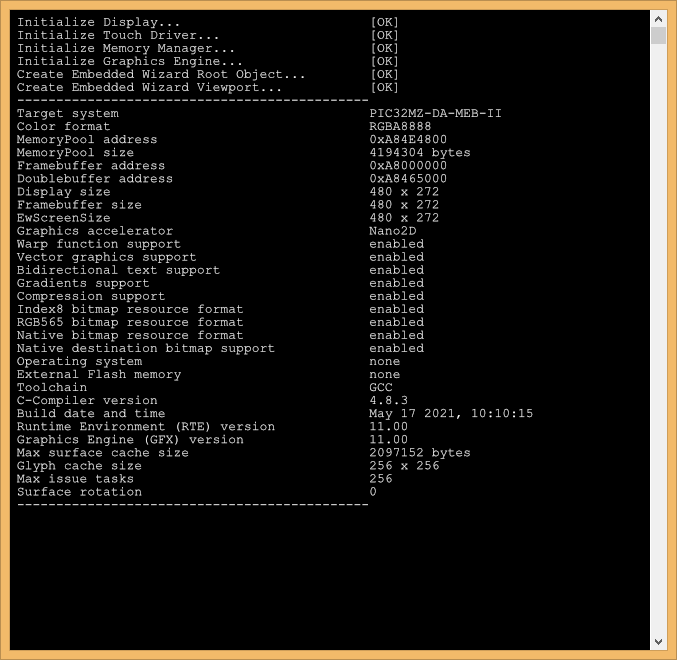
This terminal connection can be used for all trace statements from your Embedded Wizard UI applications or for all debug messages from your C code.
Using Microchip MPLAB-X
If you want to use the Microchip MPLAB-X instead of the GCC ARM embedded toolchain, please follow these instructions:
Generating Code with Embedded Wizard Studio:
★Open the desired Embedded Wizard example project. All Embedded Wizard examples will store the generated code within the common /Application/GeneratedCode folder.
★Select the Profile and set the attribute PostProcess to the file ..\..\Application\Project\MPLAB\EmbeddedWizard_PostProcess\MPLAB_ew_post_process.cmd.
★To start the code generator, select the menu items - or simply press F8. Embedded Wizard Studio generates now the sources files of the example project into the directory \Application\GeneratedCode. After the Embedded Wizard code generation the installed post process will adapt the MPLAB-X project.
Please assure, that the right version of the Harmony Configurator plug-in is installed:
★Open the plug-in window via menu .
★Check for MPLAB Harmony Configurator. If Harmony Configurator V2.06 is not installed, please change to and select com-microchip-mplab-modules-mhc.nbm below /utilities/mhc of your Harmony 2.06 installation.
★Since there is is a path length issue with MPLABX IDE, it is recommended to unpack the complete PIC32MZ-DA-MEB-II Build Environment to a short path position (e. g. below C:\Microchip). Alternatively, a symbolic link can be added on this position using Windows administrator console and mklink /D.
Compiling, linking and downloading:
★Open the MPLAB-X template project from the folder \Application\Project\MPLAB. It is commonly used for all provided Embedded Wizard examples.
★Set the EmbeddedWizard-PIC32MZ-DA-MEB-II project as main project.
★To adapt the project to your local harmony path, open the Harmony Configurator (). Open the configuration, save it and and press the button. After the Generate Project dialog opens, press the button and accept all changes by pressing the button several times.
★Select the right project configuration according to your PIC32MZ DA hardware configuration.
★Build the project using and download it to your target platform.
TIP
If the Embedded Wizard PostProcess is executed while the MPLABX project is opened in MPLABX IDE, the MPLAB project view will NOT be updated automatically.
Anyway, if using , the updated project setting will be used.
Alternatively, please close the MPLABX project before rebuilding the Embedded Wizard project and re-open it afterwards.
Release notes
The following section contains the version history of the Build Environment (including Graphics Engine and Runtime Environment) for PIC32MZ-DA-MEB-II. These release notes describe only the platform specific aspects - for all general improvements and enhancements please see the Embedded Wizard release notes.
Version 11.00
★The functions EwBspDisplayInit() and EwBspTouchInit() have been enhanced to use the size of the GUI application and display parameters.
★Code size reduction: A set of new macros wtihin the file ewconfig.h are introduced to reduce the code size of the binary application: EW_DONT_USE_GRADIENTS, EW_DONT_USE_COMPRESSION, EW_DONT_USE_NATIVE_SURFACES, EW_DONT_USE_NATIVE_SURFACES_AS_DESTINATION.
★All macros within the file ewconfig.h concerning framebuffer width/height/address/size, double-buffer width/height/addresss/size, color depths, etc. have been renamed with a leading EW_ to be in line with other macros.
